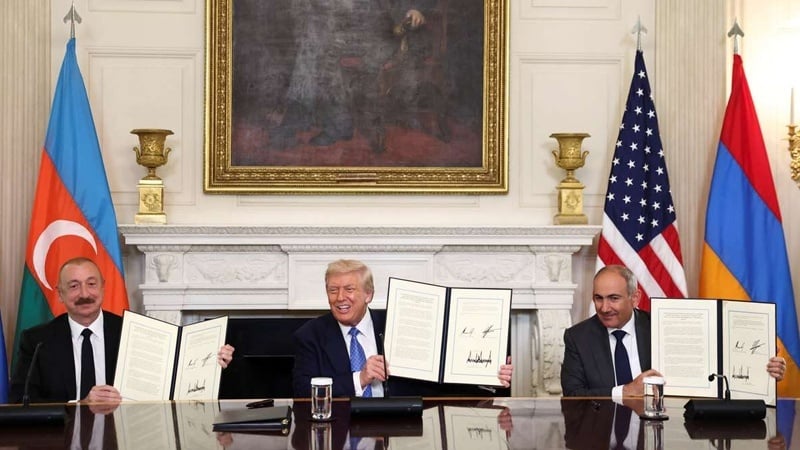Peace bridge or corridor of crisis? The danger of ceding sovereignty under the guise of a trilateral agreement
-

Peace bridge or corridor of crisis? The danger of ceding sovereignty under the guise of a trilateral agreement
Pars Today – The 99-year lease of part of Armenia’s territory to the United States has raised warnings about violations of Yerevan’s sovereignty.
Some analysts of the Caucasus affairs believe that the trilateral agreement between the United States, Armenia, and the Republic of Azerbaijan at the White House represents the completion of the U.S. project of influence in this region, as well as gaining access to the waters of the Caspian Sea.
There is also speculation that the United States and the Republic of Azerbaijan are the only real winners of this agreement, and that it will bring only a short-term pause in the dispute between Yerevan and Baku.
According to Pars Today, citing IRNA, the Prime Minister of Armenia and the President of the Republic of Azerbaijan signed a peace agreement at the White House in the presence of the U.S. President.
U.S. President Donald Trump, following the signing of the peace agreement between Armenia and the Republic of Azerbaijan, said: This declaration, called the 'Trump Route for International Peace and Prosperity,' is a special transit zone that allows the Republic of Azerbaijan full access to another part of its territory—the Nakhchivan Autonomous Republic.
The U.S. President also added that Armenia is establishing an exclusive partnership with the United States for the development of this corridor, which could last for up to 99 years.
On July 22, 2025, the Spanish outlet Periodista Digital reported that Armenia, the Republic of Azerbaijan, and the United States had agreed to sign a memorandum of understanding to create a transportation corridor known as the Trump Bridge. The Armenian government described this report as false and as another manifestation of hybrid warfare and deceptive propaganda.
On July 14, 2025, the spokesperson for Armenia’s Ministry of Foreign Affairs, rejecting the proposal for 100 years of U.S. oversight over the corridor, stated that the country has not and will not cede control of any territory under its sovereignty to any third country.
Nevertheless, Armenian Prime Minister Nikol Pashinyan and Azerbaijani President Ilham Aliyev signed an agreement at the White House, the details of some of the memoranda of understanding within which have not yet been disclosed.
The passage discussed by the leaders of the United States, Armenia, and the Republic of Azerbaijan at the White House is a transport route that some refer to as the “NATO Turanian Corridor,” which has become one of the most contentious issues since the Second Nagorno-Karabakh War.
From the perspective of some experts, this project—regardless of the benefits it brings to Azerbaijan and Turkey—seeks to strengthen NATO and Western influence in the South Caucasus while weakening Iran, Russia, and China.
The head of the Armenian government, in remarks after signing the trilateral agreement in Washington, said that through this project the country will also gain a “very important” rail link with Iran. He added that the project could become a good opportunity to initiate economic cooperation between Iran and the United States, as well as between Russia and the United States.
What Armenia gave up and what it gained
The corridor known in Azerbaijan as Zangezur and in Armenia as Syunik now bears the name of U.S. President Trump. Some experts and political analysts had previously warned about violations of Armenia’s sovereignty if this plan were implemented.
Armenian political scientist Suren Surenyants wrote on his Telegram channel on Friday night, after the signing of the trilateral agreement: The Republic of Azerbaijan and the United States have gained clear, long-term strategic and economic advantages and have strengthened their positions in the region, while Armenia has only received temporary calm—but has also acquired new dependencies, limited sovereignty, and the risk of finding itself at the center of a dangerous geopolitical game.
The trilateral agreement is not a systematic victory for Armenia
Surenyants stressed that the trilateral agreement at the White House represents only a short-term pause in tensions with Azerbaijan for Armenia, but it is not a systematic victory.
The political analyst added that Armenia has received only investment promises and loud rhetoric about becoming a “transportation hub,” without any concrete guarantees or binding commitments. In crucial and vital matters such as security, territorial integrity, and the protection of sovereignty, Armenia has achieved nothing.
Iran and Russia had previously warned about the destructive objectives of the United States in proposing connectivity projects in the South Caucasus region.
Following developments in the Caucasus region and the Friday night agreement between the Republic of Azerbaijan and Armenia brokered by the United States, the Ministry of Foreign Affairs of the Islamic Republic of Iran issued a statement stating: The Islamic Republic of Iran is ready to continue constructive cooperation based on mutual interests with both the Republic of Azerbaijan and the Republic of Armenia in order to safeguard peace and stability and promote the region’s economic development through bilateral and regional cooperation.
MG


